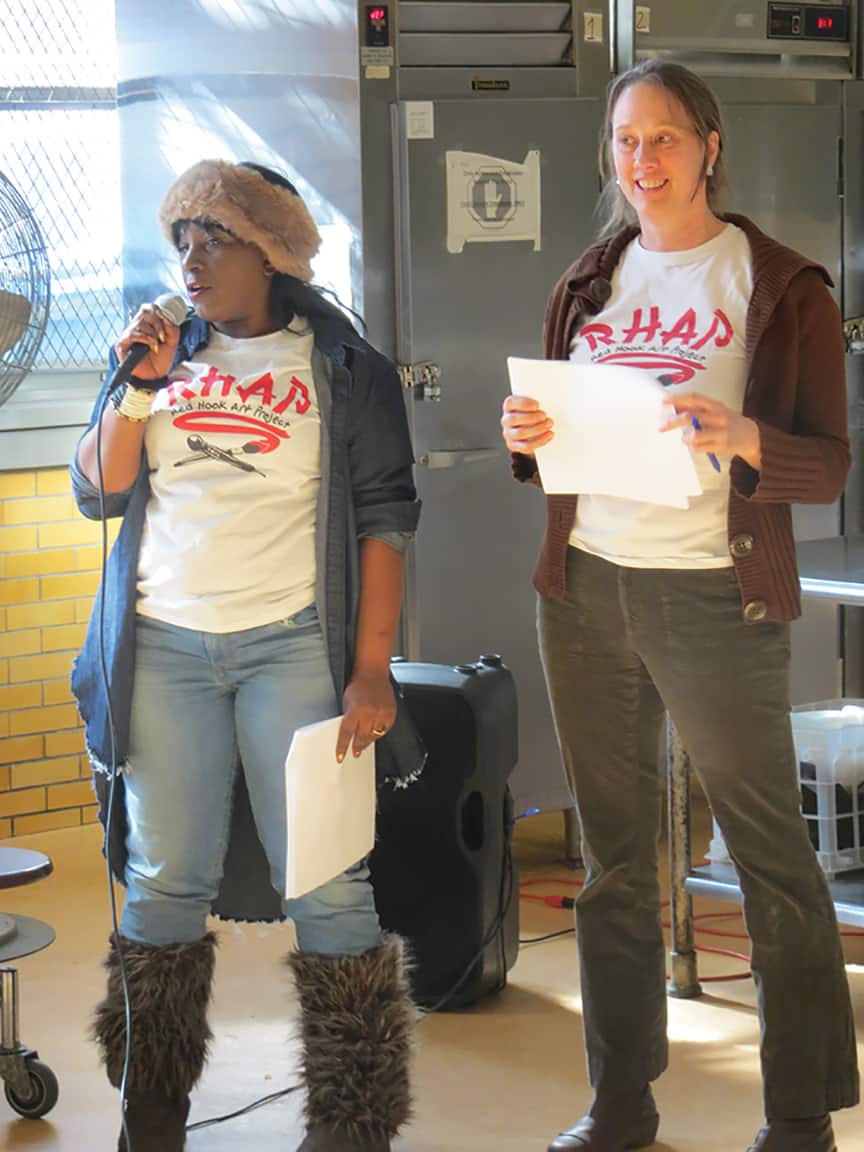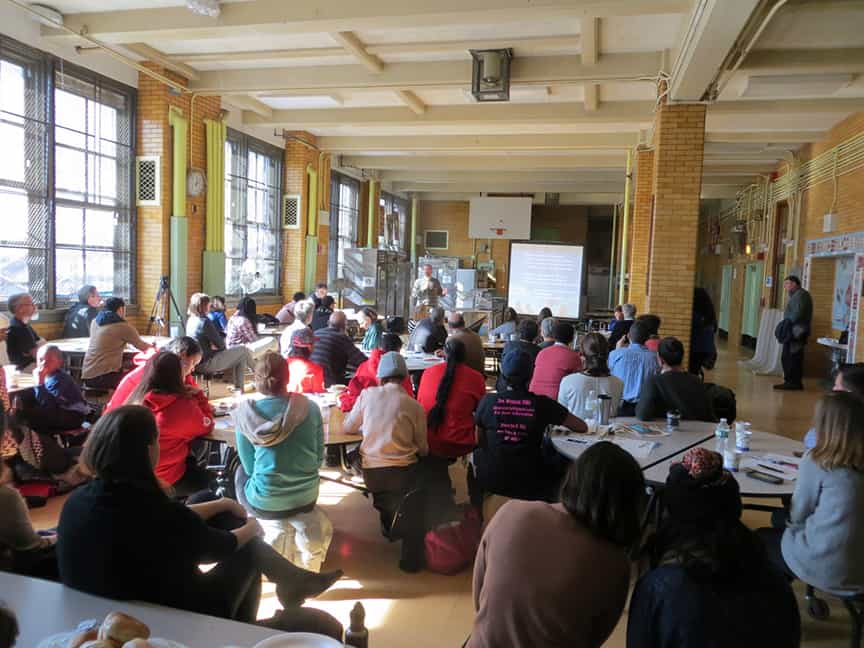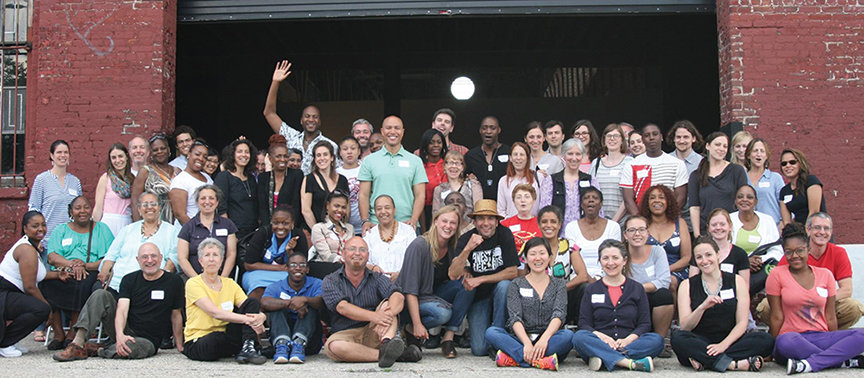The first Red Hook Summit was held in June, 2013 as the community was in initial Sandy recovery. It was an invitation-only event, held at Pioneer Works and included food and presentations on community organizing.

It was funded by a group called the Red Hook Coalition. The Coalition was put together after Sandy and was a consortium of local non profits consisting of: Red Hook Initiative (RHI); Good Shepherd Services; South Brooklyn Industrial Development Corporation (SBIDC); Added Value; The Red Hook Volunteers; Dance Theatre Etcetera and Restore Red Hook.
A goal of that summit, prepared by Reginald Flowers, founder of Falconworks, was to: “Articulate a compelling but doable practical vision for Red Hook that activates and directs community actors (leaders and residents) on a clear path for realizing community’s wellness and vitality.”
The Summit’s final report was never issued, but from documents available online it can be said that discussions included “a Full service marina, a Caribbean restaurant, a cooperative green grocer, a hardware store, more shopping, fresh meat and fish, creativity, design, arts, spirit, shops, food, street life and green industry.”
A second Summit was held January 30. This Summit was open to all, with the goal of informing the Red Hook community of the various plans being worked on to protect us from future storms.
This summit was spearheaded by Gita Nandan, chairwoman of Red Hook’s NY Rising Committee. Rising is a statewide program put together by Governor Cuomo to oversee the spending of government monies allocated to create resiliency programs. There are 76 committees throughout the state, including 15 in NYC.
The three-and-a-half-hour event at the Summit Academy was reminiscent of a trade-show, presenting the many different actors tasked with spending grant money to study and perform resiliency work.
Presenters included the Brooklyn Greenway Initiative, NYC Housing Authority (NYCHA), NYC Economic Development Corportion (NYC EDC, the NYC Office of Recovery and Resiliency, the Rising Committee, Community Board 6, RHI, Red Hook HUB, Portside, SBIDC, and Ready Red Hook.
Highlights of the session were the presentations of the Red Hook Arts Project (RHAPP), and the Red Hook Community Justice Center.
While many of the presenters were there to promote their studies and plans, both RHAPP and the Justice Center spoke of things they were doing now.
RHAPP, represented by Deirdre Swords and Tiffney Davis, told about their free local tutoring program, and their weekend art classes. These take place at their corner storefront at Richards and Dikeman Street. Not only do they offer remedial tutoring, but they help local students get into some of the city’s best high schools and colleges.

Viviana Gordon and Sabrina Carter informed the assembly about the Justice Center’s Youth Court, Peacemaking and Restitution Crew.
The latter was profiled in a recent issue of the Star-Revue. Under the supervision of a Justice Center employee, the crew, composed of people found guilty of minor crimes such as turnstile jumping, performs community service such as painting of public spaces as well as repairs in local churches and other institutions.
The Justice Center also manages a National Service Project, where students can receive college grants as a reward for their service, as well as the return of Americorps. “We are the foot soldiers in the neighborhood,” said Deputy Director Gordon.

All the speakers were accompanied by slideshows.
NYCHA showed artist renderings of new boilers and facades to be built at the Houses. These included retail spaces on the first floor of some of the buildings. It was left unclear how they will do this without removing any apartments.
Gita Nandan announced that NY Rising had received a grant from the Municipal Art Society. They sent a representative to talk about their “Livable Neighborhoods Program.”
This program is designed to education residents about community organizing and building resilient programs. According to NY Rising, this program will “give Red Hook residents additional leverage, knowledge and power to further the exciting current and on-going Red Hook projects.
The workshops are open to all and will take place on February 3 and 23 at the Miccio Center.
Alexandros Washburn, Van Brunt Street resident and professor at the Stevens Institute, has studied water-based resiliency programs worldwide.
He stressed the importance of integrating protection with the existing community – not shutting off our public spaces by building walls, but enhancing them. He showed a slide illustrating Copenhagan’s efforts, which added open space and enhanced flood protection at the same time. “Public space builds public trust,” he said. He also showed a slide from China, where a wall was built, blocking off the water from the public. This was something to avoid, he said.
The Brooklyn Greenway Initiative (BGI) has spent the past 15 years advocating and building a 29 mile bicycle pathway along the Brooklyn waterfront. BGI was represented by Milton Puryear, who spoke of adding bicycle paths above berms – combining a welcome resource with a needed one. He illustrated the proposed paths as they meander through the neighborhood, but without mentioning Est4te Four, which will own a large swath of waterfront in the coming years.
CB6’s Craig Hammerman detailed the microgrid program, providing electricity when the normal sources are cut off. This is a project that was a NY Rising winner and has received research funding. EDC came to speak of the Integrated Flood Protection System (IFPS), which was the subject of a separate meeting earlier in the week.
SBIDC spoke of a brownfield protection program, a study of retail shopping on Lorraine and Clinton Streets, and a Capacity Building Project.
The crowd was enthusiastic but some pointed out its lack of diversity. Only a handful of residents from public housing were present, although the meeting was held in its midst at the site of the old PS 27.
Dave Freeman, who works at the Justice Center, in a comment to the Star-Revue, wondered why there was so much talk and so little action. Karen Broughton, representing Assistant Speaker Felix Ortiz, appreciated the effort to present all the different programs, but suggested that a new group, composed of representatives from all the groups, would help coordinate all the activity.
In the final analysis, something is much better than nothing, and, to paraphrase Washburn, if a better quality of life emerges from all this planning and spending, it will be all well worth the effort.









One Comment
Pingback: Recap: Red Hook Community Summit – Geneseo and Red Hook, BK